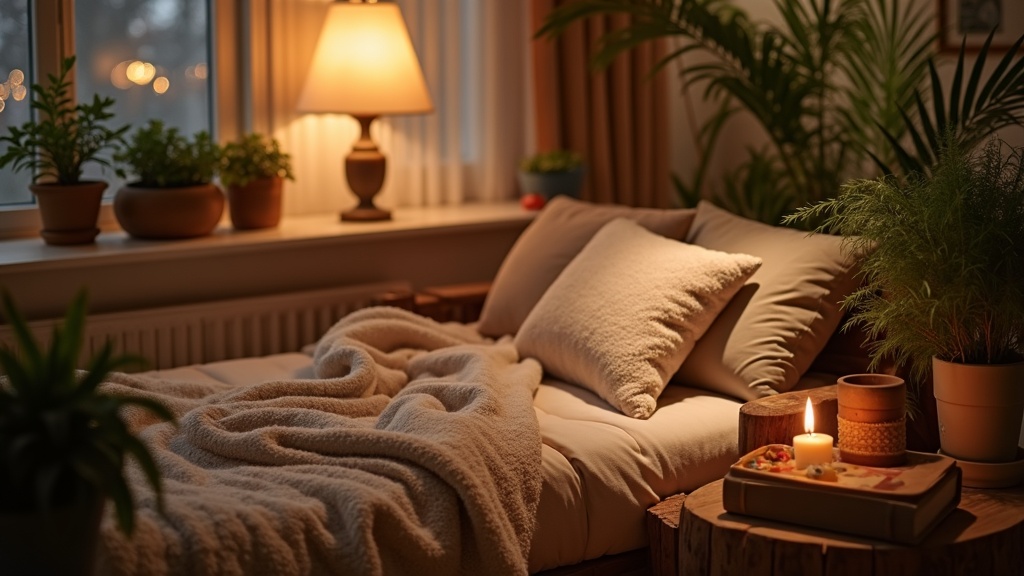A relaxation space at home offers a personal spot to unwind, recharge, and escape daily pressures. I’ve found that creating a cozy, soothing corner doesn’t take a fancy budget or a ton of space. With some thoughtful planning and a few comfort-focused details, you can easily pull together your own personal retreat, even if you haven’t tried it before.

Why A Home Relaxation Space Matters
Home is usually where I feel safest and most myself. Having an actual spot dedicated to relaxation lets me separate downtime from the daily buzz and technology. Studies show that carving out this kind of zone at home supports better stress relief, more restful sleep, and even improved focus when you return to work or chores. Setting up a personal retreat isn’t about perfection. It’s about carving out a little peace just for you and making your well-being a priority.
More than just a nice-to-have feature, a relaxation space can improve your mood and even help you better manage anxiety. Sitting back in your own comfort zone gives you the perfect opportunity to meditate, stretch, or simply zone out with your favourite playlist. Little by little, you’ll find it easier to unwind at home after even the busiest days.
Getting Started: Pick The Right Spot
You don’t need a full room to create a calm corner; a few square feet will do the trick. Start by finding a spot at home that feels a bit tucked away or naturally quiet. Some people use a spare bedroom, while others convert a section of their living room or even a sunny windowsill. I’ve even seen super relaxing spaces fit neatly under the stairs or beside a bookshelf. Natural light helps, but blackout curtains work for those who prefer a dark, cocoon-like atmosphere.
- Think about privacy: Choose somewhere you can retreat to without getting interrupted.
- Look at foot traffic: Try to avoid areas where people pass by a lot; fewer distractions make relaxing easier.
- Consider noise: If outside noise is an issue, white noise machines or a small tabletop fountain can work wonders for blocking it out.
It’s smart to track down a spot that already feels a little out of the way, but don’t be discouraged if your options are limited. A small corner, closet, or shaded nook can all be transformed into a comfort zone with a bit of creativity.
Key Elements To Help You Relax
What makes a space genuinely peaceful looks a bit different for everyone, but here are some features that work well for most people (and definitely for me):
- Comfy Seating: Whether it’s a plush chair, comfy beanbag, floor cushion, or a pile of pillows, you’ll want somewhere you can sink in and feel comfortable. I’ve even rolled out a yoga mat and called it good for meditation breaks.
- Soft Lighting: Gentle lighting sets the mood for your relaxing zone. Lamps with warm bulbs, string lights, and candles all create a chill vibe. Dimmable lamps can be really useful if you want full control.
- Warm Textures: Layer the area with throw blankets, soft area rugs, or a knit pouf. These details invite you to slow down and linger awhile.
- Natural Elements: Plants, stones, and wooden decor help bring a sense of nature indoors. I always notice that even a little greenery adds an instant freshness to the air.
- Soothing Scents: Incense sticks, essential oil diffusers, or natural candles all make a difference. Lavender, chamomile, and sandalwood are popular for promoting calmness, but I usually go with whatever scent I’m in the mood for that day.
Each of these elements adds to the sensory experience that helps your mind and body relax. Try mixing and matching whatever feels most comforting for you.
Making It Your Own: Personal Touches
One of the most satisfying parts is adding a few details that are meaningful just to you. This helps the space feel welcoming whenever it’s time to destress. Here are a few suggestions:
- Favorite books or magazines for quiet reading.
- A bluetooth speaker or oldschool radio for soft music or calming soundscapes.
- Artwork or photos that remind you of happy memories or inspire peace.
- Craft supplies, sketchbooks, or knitting baskets if creative activities help you relax.
- A journal for reflection, gratitude lists, or even just doodling thoughts away.
It’s really important to keep this zone separate from electronics like laptops or work phones. If you use your phone as a music player, put it on “Do Not Disturb” and steer clear of notifications.
Simple Steps For Setting Up Your Relaxation Space
Breaking the process down helps everything feel less overwhelming. Here’s what worked for me each time I set up a new space:
- Clear the clutter: Tidying up the area first makes a huge difference. I put away non-relaxing items like laundry baskets, paperwork, or electronics.
- Add softness: Add cushions, throws, or a thick rug. If you’re working with a hard chair, drape a blanket over it or add a fluffy pillow.
- Bring in nature: Place a potted plant, small vase with fresh flowers, or even just a bowl of pebbles on a nearby table or windowsill. Even a small succulent on a shelf can perk up your retreat.
- Set the mood lighting: Choose warm-tone lamps, fairy lights, flameless candles, or salt lamps.
- Add a scent: Place a diffuser or an unplugged essential oil roller nearby for quick access to give the mood a boost.
Take your time as you assemble your zone. Adjust things along the way if the space isn’t quite clicking. Comfort is the priority here.
Potential Challenges And How To Fix Them
Sometimes, the perfect relaxation spot needs some problem-solving. Here are a few common issues and solutions that have worked for me and some friends:
- Not enough space? Even a window seat, empty corner, or space next to your bed can work if you arrange it thoughtfully. Rolling carts store cushions, blankets, or candles without eating up lots of room. Foldaway chairs or stools can be stashed out of sight if you need the space for other activities later.
- Too much noise? Invest in a white noise machine, play soft ambient sounds, or use noisecancelling headphones. Hanging thicker curtains or adding a few heavy rugs dampens outside sounds effectively.
- Poor lighting? Clip-on lamps or battery-powered LED lights can brighten up dark nooks. If sunlight overheats a spot, install blackout curtains and bring in your own gentle lighting.
Dealing With Shared Spaces
When you don’t live alone, clear communication is key. I usually let family or roommates know when I’m using my relaxation space, so everyone’s on the same page. Some people like to add a door sign or use a visual signal (like a favorite throw on the chair) so others know you’re taking a little me-time.
Upgrading Your Home Relaxation Zone
Once you’ve got the basics down, you might want to add some extras to make things even more inviting. A small tabletop fountain adds soothing water sounds, creating a calming background. Heated blankets or foot massagers bring next-level cool comfort during colder months. I often swap out seasonal touches too, using lighter fabrics and citrus scents in summer, then moving to cozy knits and vanilla or cinnamon in winter. Small updates keep the space fresh and exciting.
- Sound support: Mini speakers or old MP3 players loaded with your favorite calming playlist can set the mood on rougher days.
- Wellness gadgets: Himalayan salt lamps, acupressure mats, or hand massagers are all little upgrades for relaxation during high-stress times.
Don’t be afraid to get creative—sometimes reshuffling the furniture or adding a second plant can brighten up even the tiniest area. Look for small ways to keep your spot feeling special.
Real-World Examples and Inspirations
I’ve seen some creative relaxation spaces over the years, ranging from tiny reading nooks lined with string lights to small balcony gardens filled with potted lavender and comfortable cushions. One friend added peel-and-stick wallpaper to separate his relaxation corner from the rest of his living room. Another keeps a little tray of tea supplies and a mug handy, making a warm drink part of her evening ritual. There’s no single right way; the key is what feels genuinely comforting to you.
- Minimalist nooks: Just a clean mat, a low bench, and a single plant work well; simple but effective.
- Nature-Inspired spaces: Leafy plants, wood accents, and calming landscape prints on the walls can dial up the relaxing mood.
- Mixed zones: Combining reading, creative hobbies, and sensory relaxation in one spot lets you switch things up based on your mood.
If you’re stuck for ideas, check out social media platforms or magazines for quick inspiration. Photos of cozy reading corners or meditation spaces are popular and can give you new ideas for small touches to add to your own zone.
Frequently Asked Questions
Question: Can I set up a relaxation space with limited budget or space?
Answer: Absolutely. Focus on what soothes you most. One comfy pillow, soft lamp, and favourite book can start your mini sanctuary without breaking the bank or taking up lots of space. Look out for thrift store finds or DIY decor to bring even more personality into your nook.
Question: How do I keep this space feeling special over time?
Answer: Refresh things every so often; swap out throw blankets, add new scents, or rotate in different relaxing playlists. Keeping it decluttered and using it regularly helps too. If you’ve got a favourite season or holiday, try bringing in themed accents now and then to shake things up.
Question: Is there a way to make a multipurpose relaxation area?
Answer: Yup, just use baskets or boxes to store items out of sight when you switch between reading, stretching, or listening to music. A lightweight screen or large indoor plant creates a little separation, even in an open-plan apartment. The secret is picking versatile furniture and accessories that you can move around as needed without hassle.
Final Thoughts
There’s something pretty special about stepping into your own relaxation corner after a long, busy day. Whether you invest in fancy gadgets or repurpose things you already have, the real benefit comes from being intentional about how and where you relax in your home. With a few mindful choices and some trial and error, you’ll track down a spot that helps refill your cup whenever you need it. Take time to experiment, and don’t be afraid to adjust things as your needs and lifestyle change. Your home relaxation space should always be an oasis that welcomes you back for a well-earned break.
